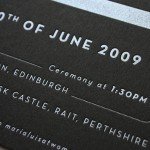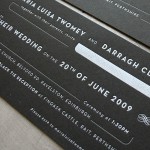Setting the tone for a black tie event with rich black paper just seems logical. Black paper should actually be a requirement if you are having a reception in a castle. (insert jealous sigh here) This contemporary type and linear design is letterpress printed with silver ink on 250gsm Stonehenge Black Paper in a horizontal format. It’s nice to see the type arranged outside typical wedding layouts. These invites were designed by a fantastic design firm - Field - based out of Copenhagen and Dublin. Which goes to show we are happy to letterpress print custom work for designers everywhere.











7 Comments
The inset pantone type looks amazing on the black paper. Thanks for the post and +stumble, inspiring for how I’ll design my wedding cards :)
We once printed an invite for a wedding in Edinburgh, too. The bottom of the invite read: “kilts and party frocks. carriages at midnight.” Le sigh.
I love this! Slick and clean and white on black stock is just gorgeous, good job :)
Thanks - It is silver ink to achieve an opaque print on the black paper.
how many times did you have to hit that to work? We’ve never had good results with metallics and letterpress
This is a single pass of silver. This was run on our Vandercook Universal III Cylinder press. The more robust the ink system on a press, the easier it is to lay down great density and still hold onto the detail.
Would you reveal your ink manufacturer? I’ve never been able to achieve that kind of coverage with a single pass with my SP-15, which I would think would have a comparably “robust” inking system. I’ve always wondered if the Van Son PMS 877 that I use is perhaps not as dense with pigment as is possible in an ink.
2 Trackbacks
[...] Jeff, KE9V put an intriguing blog post on Black Tie & Black Paper: Wedding In EdinburghHere’s a quick excerpt…sigh here) This contemporary type and linear design is letterpress printed with silver ink on 250gsm Stonehenge Black Paper in a horizontal… [...]
[...] Beast Pieces May 7th, 2009 | found in design Cufon.now(); var gaJsHost = ((”https:” == [...]